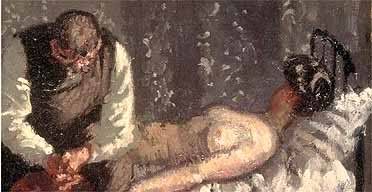Among the pallid faces and the heads in hands is a bubbly American woman who has staple-gunned a piece of wood to her thumb and a Scottish bloke with a suitcase.
He’s trying to chat up a girl with broken fingers – the result of a karate chopping nephew.
It’s University College Hospital’s annual open day but around the corner from the main entrance, where Gloria Hunniford is turning on the Christmas lights, it’s just another day in A + E.
 London’s Tottenham Court Road is famous for its technology retailers.
London’s Tottenham Court Road is famous for its technology retailers. Since 2005, the top end of this gadget Mecca has also been an appropriate home for one of the capital’s newest hospitals.
Today is a chance for healthy members of the public to find out what goes on behind closed doors inside this modern hospital.
UCH is big and glassy, woven together with white-painted steel.
It’s the antithesis to the gothic and ultra intricate St. Pancras station, not far away down the Euston Road.
As I stand outside the huge atrium that forms the main entrance to the hospital, a couple of men in suits are scurrying around studying surfaces for imperfections - “That needs cleaning, that needs polishing, and when is this getting painted?”
Today the sun seems to have barely lifted its shoulders above the horizon before going back to bed.
It’s gloomy outside but the huge Christmas tree and genuinely amazing carol singers help to brighten the spirits inside.
Their voices soar in the cathedral-like space.
A queue has formed in front of the table where tours of the different departments can be booked.

Pensioners are battling for slots on the most popular tours and when I am given a pass to A+E without queuing, my explanation that I am writing an article is met with unsatisfied glares through wrinkled eyes.
Blood, guts, vomit, chest-pounding heroics and a conveyor belt of lives brought back from the brink – this is emergency medicine, at least if you watch a lot of TV it is.
The public perception of what goes on behind closed doors in A+E makes this chance to tour the department a popular one.
Dr. Adeyoke, an A+E registrar at UCH somewhat dispels the myth that patients are regularly brought back from the dead after being zapped with electricity.
Indeed his single most memorable event after two years of working at UCH was a scenario like this.
“A young, middle-aged man came in with pulseless electrical activity”, a particularly bad kind of heart attack, “ and working as a team we managed to stabilise him and get him to intensive care”, he said.
Unrealistic expectations are sometimes placed upon A+E doctors as we imagine them flying around the department with their chests puffed out and a white coat flapping in the wind like a super-hero’s cape.
These people are humans and humans inevitably make mistakes.
Dr. Adeyoke says, “The hardest part of the job is the time constraints. There is such pressure and we can be prone to errors as a result”.
Back in the hospital atrium, the carol singers have finished and Kokila Gillett, a solo musician is performing traditional Indian music.
Before the tour begins, I drag myself away from the festivities and take in the delights of the A+E waiting room.
 Facial expressions range from boredom to wincing pain, with not much in between apart from a beaming smile on the face of the cleaner who is gently chuckling to herself as she mops the floor.
Facial expressions range from boredom to wincing pain, with not much in between apart from a beaming smile on the face of the cleaner who is gently chuckling to herself as she mops the floor. From behind protective glass, a receptionist loudly asks a sheepish looking man, “When did you last open your bowels?”
The Scottish man with the brightly coloured suitcase has just arrived on a train from Dundee.
He sits down near to the girl with the broken fingers who has suffered at the hands of an overzealous relative, playing ninja.
“Are you married, love?” he asks, thirty seconds into their conversation.
She gently rebuffs him in a cockney accent that an American tourist would queue up to hear.
With this soap opera playing out around me, I’m a little aggrieved that the tour is about to start but I reluctantly join the group anyway.
We silently traipse around the department behind our amiable tour guide, trying not to get in the way.
Doctors cluster around light-boxes, carefully studying x-rays for signposts towards a diagnosis.
The atmosphere is industrious but calm.
I have my fingers crossed for somebody to come bursting through the swing-doors from the ambulance bay with a knife sticking from their back or something suitably dramatic.
No such luck. Our tour through the slick department passes without incident.
I remember my chat with Dr. Adeyoke - “It’s not like it is on TV”, he assured me.
Perhaps that’s because he doesn’t spend much time in the waiting room.
Great characters played out romance, comedy, pain and suffering in my thirty minutes there.





